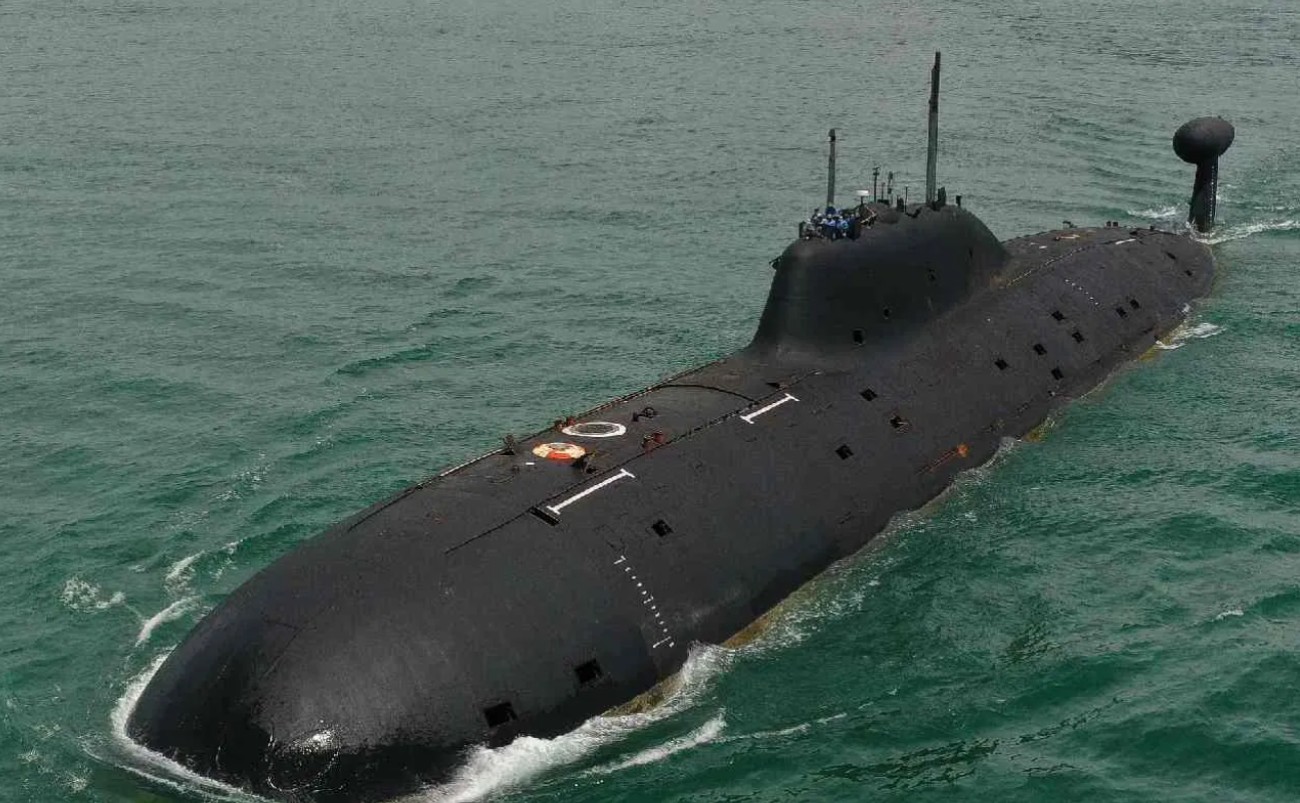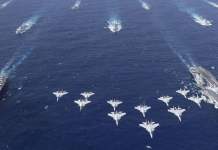To maintain credible nuclear deterrence, any country needs an invulnerable second-strike capability. But the sea legs of India’s nuclear triad are still a work in progress (WIP).
With Eye On China, Pakistan Air Battles, India Forward Deploys Its LCA Tejas Fighters For Ultimate Clash
The range of its nuclear-tipped K-15 missiles is just 750 kilometers, barely managing to have only southern Pakistan regions in its target range.
Also, the lack of at least three operational submarines means that the submarines are primarily in and out of the harbor without maintaining constant nuclear deterrence.
India presently has two nuclear-powered ballistic submarines (SSBNs) dubbed Advanced Technology Vessels (ATV). The first of these two is S2 (INS Arihant) and S3 (INS Arighat).
INS Arihant, the first indigenous SSBN, was launched in 2009 and commissioned in 2016. In November 2019, INS Arihant completed its first deterrence patrol, the Indian government announced the establishment of the country’s “survivable nuclear triad” – the capability to launch nuclear strikes from land, air, and sea platforms.
Then Defense Minister Nirmala Sitharaman tweeted: “India has achieved completion of her nuclear triad with the first successful deterrence patrol by INS Arihant. This places India in the league of the few countries that can design, construct and operate Strategic Strike Nuclear Submarines (SSBN).”
Besides being a technology demonstrator, INS Arihant has been an achievement for the Indian indigenization program. When the ATV met with an accident in 2017, India had no nuclear triad.
A human error resulted in water rushing in as a hatch on the rear side was left open by mistake at the harbor. Its propulsion compartment was damaged after water entered it.
“India has a ‘no first use’ policy when it comes to nuclear weapons. A country needs invulnerable second-strike capability, which is what SSBNs give you. INS Arihant is a technology demonstrator,” an Indian naval officer told the EurAsian Times, requesting anonymity.
The first indigenous submarine, INS Arihant, is a 6,000-ton ship powered by an 83 MW pressurized light water reactor (PWR) fuelled with enriched Uranium. It is 110 meters long with an 11-meter-wide beam and can travel up to 24 knots underwater.
The Indian Project to build a credible nuclear deterrence has been shrouded in secrecy since its inception. As India realized its goal to operate an SSBN with the help of Russian aid, it gained experience operating a nuclear-powered submarine leased from Russia.
“Accidents notwithstanding, we have gained valuable experience operating SSNs and SSBNs. Operating SSBNs need a complex network of control and communication. That is what Arihant’s patrol has proven, and now is the time to up our game,” said the officer.
“For nuclear deterrence, one submarine always needs to be on patrol. If Arihant is in and out of the harbor, it is not exactly a deterrence,” the officer added. “We need 3-4 SSBNs so we can keep one on patrol when one may be in port, one going for patrol, and one coming back,” he explained.
Buttressing his point, the officer referred to 52 years of Continuous Sea Deterrent (CASD), the UK’s longest sustained military operation ever. “If one cannot sustain it, it is hardly a deterrence,” the officer concluded.
To remedy the situation, India has got another SSBN INS Arighat operational. Satellite images have indicated the launch of a third in the series codenamed S4 (S4* is also in the offing) at the secretive Ship Building Centre in Visakhapatnam.
British publication Janes further reported that satellite imagery had confirmed that at 7,000 tons, the S4 SSBN was ‘slightly larger,’ with a load water line measurement of 125.4m compared with 111.6m of the 6,000-ton ‘baby boomer’ INS Arihant, the lead boat in this class. It categorized the S4 – and successive boats – as ‘Arihant-stretch’ variants.
Survivable Second-Strike Capability
A total of six SSBNs are planned for the future, and together they will be part of India’s survivable second-strike capability.

In case of a nuclear conflict, the highest level of survivability lies with equipping nuclear-powered submarines with ballistic missiles with sufficient ranges. Since the submarine-launched ballistic missile first came into being, they have been considered the most survivable delivery system as ocean depths remain opaque to a large extent.
A US nuclear submarine captain described the American Polaris submarine as “an extremely survivable assured capability that the Soviets knew they could not destroy and knew if they conducted a first strike, that system would someday be available to retaliate.
It might take some time to get the message to them from a destroyed national headquarters, but someday the missile warheads would come raining in, and they would pay the price.”
In light of this, every nuclear weapon state aimed for a nuclear triad. However, over the years, countries have given up some nuclear delivery platforms in favor of SLBMs because of their high survivability quotient. For instance, the UK maintains its nuclear forces only on its four submarines; France maintains a dyad in the SLBM and air delivery platforms.
From K-15 To K-4 Nuclear-Tipped Missiles For Indigenous Submarines
The K-15 missiles fitted on INS Arihant have a range of 750 km, which is woefully short of hitting anything significant in China, which is currently a prime adversary for India.
Even in a conflict with Pakistan, it would only have targets within its range in the south of the country. These are the first indigenously-developed short-range submarine-launched ballistic missiles (SLBMs).
One of the big challenges in the sea leg of nuclear deterrence is that an underwater vertical launch system is among the most sophisticated and complex weapons since it demands stability, speed, and accuracy in a twin medium – water and atmosphere.
As Manpreet Sethi, a nuclear expert at the Center for Air Power Studies, adds in her issue brief: “Unless the SLBMs have a range that can help deploy the submarine out of harm’s way, the vessel would not only be constrained for deployment but also become more a liability than an asset. India is yet to develop missiles with adequate ranges.”
Efforts are underway to develop K-4 submarine-launched ballistic missiles with a 3500-kilometer range. The S4 and S4* are expected to be fitted with K-4 missiles. The need for long-range submarine-launched missiles corresponds to the increasing tensions in the Indo-Pacific region.
In the Indian neighborhood, only China has SSBNs, which have been deployed in the past for “counter-piracy patrols” off the east coast of Africa. However, Chinese anti-submarine warfare is in a nascent stage.
Given the threat assessment for India, SSBN promises a guarantee of survivability of nuclear retaliatory capability. With its long coastlines and peninsula, the SSBNs can remain hidden in ocean depths during the conflict to ensure the survival of second-strike capability.
- Ritu Sharma has been a journalist for over a decade, writing on defense, foreign affairs, and nuclear technology.
- She can be reached at ritu.sharma (at) mail.com




